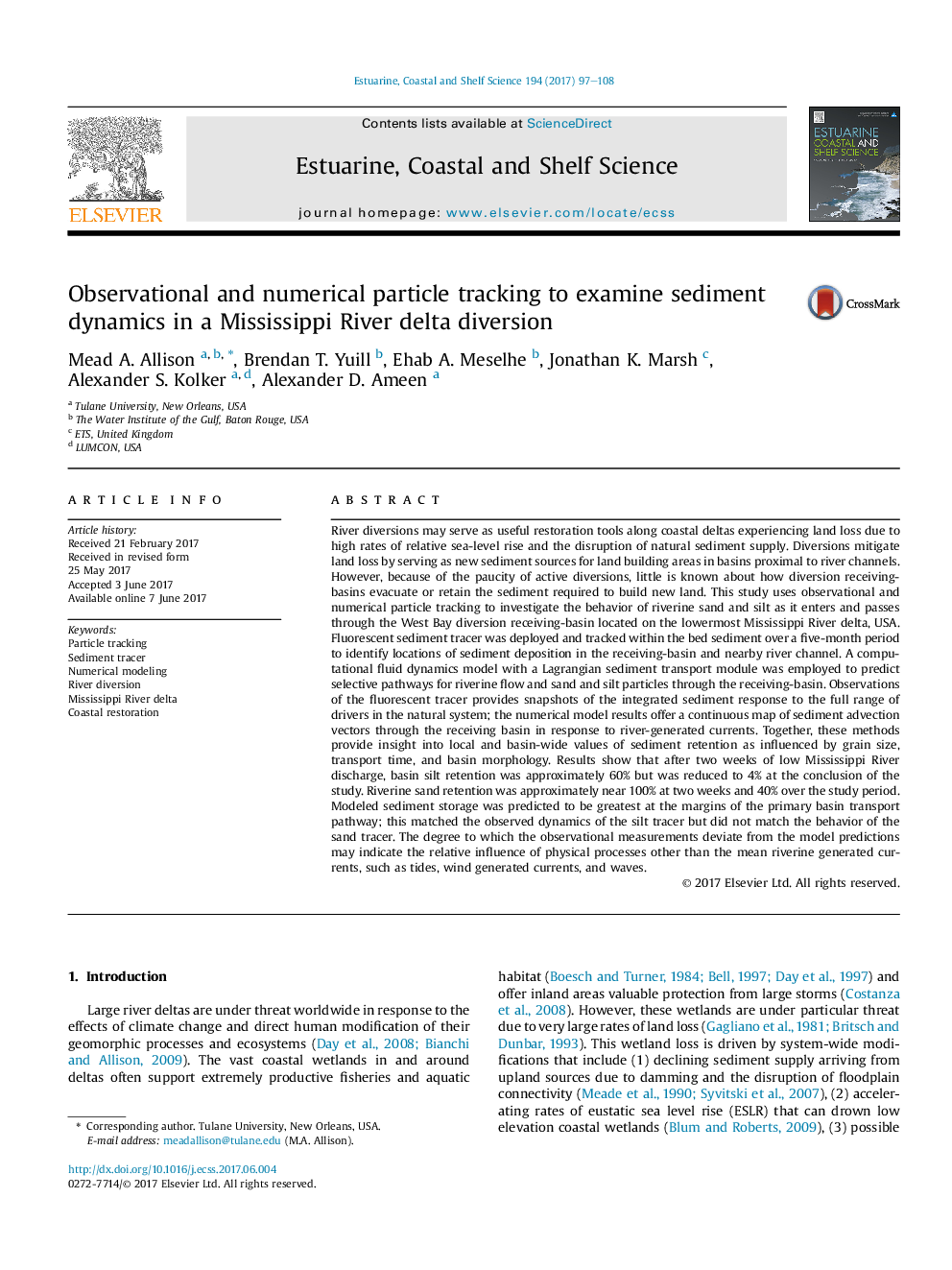| کد مقاله | کد نشریه | سال انتشار | مقاله انگلیسی | نسخه تمام متن |
|---|---|---|---|---|
| 5765089 | 1626608 | 2017 | 12 صفحه PDF | دانلود رایگان |
عنوان انگلیسی مقاله ISI
Observational and numerical particle tracking to examine sediment dynamics in a Mississippi River delta diversion
ترجمه فارسی عنوان
ردیابی ذرات مشاهده شده و عددی برای بررسی دینامیک رسوب در انحراف دالت رودخانه می سی پی
دانلود مقاله + سفارش ترجمه
دانلود مقاله ISI انگلیسی
رایگان برای ایرانیان
کلمات کلیدی
ردیابی ذرات، ردیاب رسوب، مدل سازی عددی، انحراف رودخانه، دلتای رودخانه می سی سی پی، بازسازی ساحلی،
ترجمه چکیده
انحرافات رودخانه ای ممکن است به عنوان ابزار بازسازی مفید در طول دلتاهای ساحلی به علت بالا رفتن سطح نسبی سطح دریا و اختلال در عرضه رسوبات طبیعی، از دست رفتن زمین برخوردار باشد. انحرافات کاهش خسارات ناشی از خدمت به عنوان منابع جدید رسوب برای مناطق زمین سازی در حوضه های نزدیک به کانال های رودخانه را کاهش می دهد. با این حال، به دلیل کمبود فعالیت های فعال، در مورد چگونگی تخلیه و یا حفظ رسوب مورد نیاز برای ساخت سرزمین های جدید، کم اهمیت است. این مطالعه از مشاهدات و ردیابی ذرات عددی برای بررسی رفتار شن و ماسه رودخانه و گرده در هنگام ورود و عبور از حوضه نفوذ پذیری غربی غرب واقع در دلفای رودخانه میسیسیپی، ایالات متحده آمریکا استفاده می کند. رسوب فلورسنت رسوب در طی رسوب 5 ماهه برای شناسایی مکان رسوب رسوب در حوضه ی دریافتی و کانال رودخانه ی مجاور مستقر شده و ردیابی می شود. یک مدل دینامیکی سیال محاسباتی با یک ماژول انتقال رسوب لاگرانژی برای پیش بینی مسیرهای انتخابی جریان جریان رودخانه و ذرات شن و ماسه از طریق حوضه دریافت شده مورد استفاده قرار گرفت. مشاهدات ردیاب فلورسنت، عکس هایی از پاسخ رسوب یکپارچه را به طیف وسیعی از رانندگان در سیستم طبیعی فراهم می کند؛ نتایج مدل های عددی ارائه یک نقشه مداوم از بردارهای پیشگیری از رسوب از طریق حوضه دریافت در پاسخ به جریان های تولید شده در رودخانه است. با هم، این روش ها بینش به ارزش های محلی و حوضه های نگهداری رسوب را تحت تاثیر اندازه دانه، زمان حمل و نقل و مورفولوژی حوضه. نتایج نشان می دهد که پس از دو هفته از تخلیه رودخانه میسیسیپی کم، میزان احتباس سیلاب حوضه تقریبا 60٪ بود اما در پایان مطالعه به 4٪ کاهش یافت. نگهداری شن و ماسه رودخانه در دو هفته تقریبا 100٪ بود و در طول دوره مطالعه 40٪ بود. ذخیره سازی رسوب مدل شده در حاشیه مسیر انتقال حوضه اولیه بزرگترین پیش بینی شده بود؛ این به دینامیک مشاهده شده ردیاب سیلت هم بستگی داشت ولی با رفتار ردیاب شن و ماسه مطابقت نداشت. درجه ای که اندازه گیری های مشاهداتی از پیش بینی مدل ها متفاوت است، می تواند تاثیر نسبی فرایندهای فیزیکی را به غیر از جریان های تولید شده در رودخانه مانند جزر و مد، جریان های تولید شده با باد و امواج نشان دهد.
موضوعات مرتبط
مهندسی و علوم پایه
علوم زمین و سیارات
زمین شناسی
چکیده انگلیسی
River diversions may serve as useful restoration tools along coastal deltas experiencing land loss due to high rates of relative sea-level rise and the disruption of natural sediment supply. Diversions mitigate land loss by serving as new sediment sources for land building areas in basins proximal to river channels. However, because of the paucity of active diversions, little is known about how diversion receiving-basins evacuate or retain the sediment required to build new land. This study uses observational and numerical particle tracking to investigate the behavior of riverine sand and silt as it enters and passes through the West Bay diversion receiving-basin located on the lowermost Mississippi River delta, USA. Fluorescent sediment tracer was deployed and tracked within the bed sediment over a five-month period to identify locations of sediment deposition in the receiving-basin and nearby river channel. A computational fluid dynamics model with a Lagrangian sediment transport module was employed to predict selective pathways for riverine flow and sand and silt particles through the receiving-basin. Observations of the fluorescent tracer provides snapshots of the integrated sediment response to the full range of drivers in the natural system; the numerical model results offer a continuous map of sediment advection vectors through the receiving basin in response to river-generated currents. Together, these methods provide insight into local and basin-wide values of sediment retention as influenced by grain size, transport time, and basin morphology. Results show that after two weeks of low Mississippi River discharge, basin silt retention was approximately 60% but was reduced to 4% at the conclusion of the study. Riverine sand retention was approximately near 100% at two weeks and 40% over the study period. Modeled sediment storage was predicted to be greatest at the margins of the primary basin transport pathway; this matched the observed dynamics of the silt tracer but did not match the behavior of the sand tracer. The degree to which the observational measurements deviate from the model predictions may indicate the relative influence of physical processes other than the mean riverine generated currents, such as tides, wind generated currents, and waves.
ناشر
Database: Elsevier - ScienceDirect (ساینس دایرکت)
Journal: Estuarine, Coastal and Shelf Science - Volume 194, 15 July 2017, Pages 97-108
Journal: Estuarine, Coastal and Shelf Science - Volume 194, 15 July 2017, Pages 97-108
نویسندگان
Mead A. Allison, Brendan T. Yuill, Ehab A. Meselhe, Jonathan K. Marsh, Alexander S. Kolker, Alexander D. Ameen,
